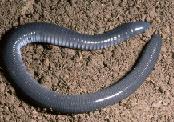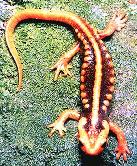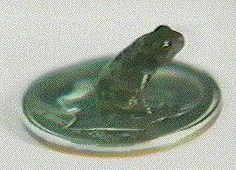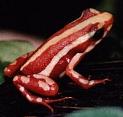Amphibia
Reminder: Clicking on the picture will take you to the site where I originally found it.
 As the story goes, millions of years ago, a fish flopped onto the land. Perhaps it could get a tasty snack, or perhaps avoid getting eaten, but there it was - a fish out of water. Over time, it was to the advantage of some of the fish to spend more time out of water. Lungfish developed. From there it was oly a short leap to the class of animals known as amphibians.
As the story goes, millions of years ago, a fish flopped onto the land. Perhaps it could get a tasty snack, or perhaps avoid getting eaten, but there it was - a fish out of water. Over time, it was to the advantage of some of the fish to spend more time out of water. Lungfish developed. From there it was oly a short leap to the class of animals known as amphibians.
So, what makes a creature an amphibian? They all lay eggs which are known as "unamniotic." This means the eggs can't sustain their own moisture, and must remain in water. The skin of amphibians is different because it has no hair, scales or feathers. Instead, it has glands which produce a layer of mucous. In some, this is poisonous. Amphibians often have a pair of lungs and a three chambered heart.
Amphibians are split between two worlds. In their early days, they strongly resemble fish. All amphibian eggs must remain in water. After they hatch, all amphibians have gills and swimming fins. After a time, they undergo transition. For salamanders and caecilians, the change may not be horribly drastic, but in the frogs and toads, it's quite astonishing.
Frogs and toads have been favorite subjects for dissection in biology labs for years. This was because they were readily available and few people had any problem offing a bunch of "slimy" old amphibians. Currently, there is a movement away from dissecting these animals. Frogs and toads have been disappearing from the world ecosystems. Their life in two environments make them susceptable to pollutants and a high number of deformed frogs have been noted. People are re-thinking how we treat these creatures.
Here is a little more information on the various orders of amphibians:
Order: Apoda or Gymnophionia (Caecilians)
 Caecilians have the cool nickname of being "rubber eels." They look a little like worms, but they're amphibians all the way. They move like water snakes.
Caecilians have the cool nickname of being "rubber eels." They look a little like worms, but they're amphibians all the way. They move like water snakes.
True to their amphibian nature, they have lungs. They must surface for air, but they live their lives underwater. Caecilians have internal fertilization and give birth to live young.
This next paragraph was so cool, I had to include it word for word. The original quote is located elsewhere.
Rubber eels are dumber than most tropical fish, and have considerable difficulty dealing with food that moves. They have only moderate difficulty with food that doesn't move. They are extremely confused by other bottom-feeders. We think they are cute, and it's great to have one who insists on being hand-fed and will curl up in your hand and wrap itself around your fingers. Smarter animals run from large mammals in the water.
Ah, don't ya just love honesty among animal lovers?
Generally speaking, cacelians are peaceful creatures who live in the bottom of fresh water. They don't harm humans and are only found in South America. Theyre odd, but there is room enough in this world for another odd order of animals.
Order: Urodela or Caudata (Newts and salamanders)
 The order known as caudata is a group which includes salamanders and newts. These are legged amphibians who keep their tails into their adult years. All of these animals have gills when a larva, but when adult they breathe through lungs or moist skin. Let's do a run-down of the main families.
The order known as caudata is a group which includes salamanders and newts. These are legged amphibians who keep their tails into their adult years. All of these animals have gills when a larva, but when adult they breathe through lungs or moist skin. Let's do a run-down of the main families.
Proteidae, or mud puppies are native to the United States and Europe. This is an amphibian, but it keeps its large gills throughout life. It can use these when submerged for long periods of time.
Sirenidae, or sirens are unusual. Like the mud puppy, it keeps its gills throughout life, but there is something even stranger. No back legs. The front half looks like a salamander, but the back half looks eel-like. They haven't been observed to breed, but they're located throughout the south-eastern United States where life is moist.
Cryptobranchidae is commonly called the hellbender. They're native to the United States along rivers and streams in the east. Some are in China and Japan. They're big ol' critters. They can be found under rocks and logs in the water. In spite of the rather formidable name, they're harmless creatures.
Ambystomidae is called the spotted salamander or mole salamanders. Again, you can find these in the super-moist eastern U.S. These salamanders tend to burrow and hide, making them hard to detect most of the year. The mole salamanders tend to migrate in the spring. They come out when the thaw causes water levels to rise. They find the next appropriate pool and make a life for themselves.
Salamandridae are the newts. They look a lot like lizards, but they have no scales or claws. Their skin is smooth and moist. These are basically the same thing as salamanders. There's not a huge difference. They look like gekkos or other lizards, but they are amphibians, and need to remain in moist environments.
Plethodontidae is the lungless salamander. These are located throughout the world wherever it is moist and temperate. As you can probably guess from the name, they lack lungs. They don't use gills either. They absorb oxygen straight through their skin. Cool, huh?
Order: Salientia or Anura (frogs and toads)
 Congratulations, you've found the frogs and toads. These are all in the salientia order. Of all the amphibians, these undergo the biggest transformation from larval to adult stage. They have a very disstinctive life cycle. They hatch from eggs in a pond or another body of water. In their larval stage they are known as tadpoles. They breathe through gills, but this doesn't last forever. Their legs grow, their tails shrink, and breathing is taken over by new lungs.
Congratulations, you've found the frogs and toads. These are all in the salientia order. Of all the amphibians, these undergo the biggest transformation from larval to adult stage. They have a very disstinctive life cycle. They hatch from eggs in a pond or another body of water. In their larval stage they are known as tadpoles. They breathe through gills, but this doesn't last forever. Their legs grow, their tails shrink, and breathing is taken over by new lungs.
By the way, do you know the difference between toads and frogs? Frogs are smooth and slimy, but toads are dry and warty.
Find out more about the different orders of frogs!
Pelobatidae are the spadefoot toads. They look like normal toads, but they have a big claw on their hind feet. They use this for digging.
Bufonidae are the true toads. These are very common and we have several species in Utah. Toads are found everywhere. They like moisture, and so you'll find toads wherever they can get enough. Their skin, warts and all, is tougher than that of a frog and thicker too. They can live where there isn't as much moisture. And speaking of warts, you CAN'T get warts from handling a toad, but make sure you wash up afterwards. All amphibians secrete substances which may be irritating.
Hylidae are the green tree frogs. Many have specialized suction cups on their feet which allow them to climb trees. Not all do though. Some build mud nests at the edge of the water so their eggs can drop in when conditions are right. One frog, called the marsupial tree frog, has specialized pouches on the female's back where she raises the tadpoles. At any rate, the tree frogs are fun.
Ranidae are the true frogs. These are the most common of frogs amd are found on all continents. In the U.S., the bullfrog is the most familiar of examples. Kermit the Frog is one of the ranidae. His webbed feet give it away. And never forget Jeremiah. Jeremiah was a bullfrog.
Microhylidae are narrow mouthed frogs or toads. They have pointy little heads. While the narrow-mouthed amphibians live mostly in the tropics, there are some in the south-eastern U.S. Boy, that's a happy place for amphibians.
 Last but not least are the dendrobatidae, or the poison dart frogs. These tend to be the brightest colored and most poisonous frogs. Usually, the brighter the colors, the more poisonous the frog is. These are native to Central and South America.
Last but not least are the dendrobatidae, or the poison dart frogs. These tend to be the brightest colored and most poisonous frogs. Usually, the brighter the colors, the more poisonous the frog is. These are native to Central and South America.
Back to the Chordate page, or
to the overview.
 As the story goes, millions of years ago, a fish flopped onto the land. Perhaps it could get a tasty snack, or perhaps avoid getting eaten, but there it was - a fish out of water. Over time, it was to the advantage of some of the fish to spend more time out of water. Lungfish developed. From there it was oly a short leap to the class of animals known as amphibians.
As the story goes, millions of years ago, a fish flopped onto the land. Perhaps it could get a tasty snack, or perhaps avoid getting eaten, but there it was - a fish out of water. Over time, it was to the advantage of some of the fish to spend more time out of water. Lungfish developed. From there it was oly a short leap to the class of animals known as amphibians. Caecilians have the cool nickname of being "rubber eels." They look a little like worms, but they're amphibians all the way. They move like water snakes.
Caecilians have the cool nickname of being "rubber eels." They look a little like worms, but they're amphibians all the way. They move like water snakes. The order known as caudata is a group which includes salamanders and newts. These are legged amphibians who keep their tails into their adult years. All of these animals have gills when a larva, but when adult they breathe through lungs or moist skin. Let's do a run-down of the main families.
The order known as caudata is a group which includes salamanders and newts. These are legged amphibians who keep their tails into their adult years. All of these animals have gills when a larva, but when adult they breathe through lungs or moist skin. Let's do a run-down of the main families. Congratulations, you've found the frogs and toads. These are all in the salientia order. Of all the amphibians, these undergo the biggest transformation from larval to adult stage. They have a very disstinctive life cycle. They hatch from eggs in a pond or another body of water. In their larval stage they are known as tadpoles. They breathe through gills, but this doesn't last forever. Their legs grow, their tails shrink, and breathing is taken over by new lungs.
Congratulations, you've found the frogs and toads. These are all in the salientia order. Of all the amphibians, these undergo the biggest transformation from larval to adult stage. They have a very disstinctive life cycle. They hatch from eggs in a pond or another body of water. In their larval stage they are known as tadpoles. They breathe through gills, but this doesn't last forever. Their legs grow, their tails shrink, and breathing is taken over by new lungs. Last but not least are the dendrobatidae, or the poison dart frogs. These tend to be the brightest colored and most poisonous frogs. Usually, the brighter the colors, the more poisonous the frog is. These are native to Central and South America.
Last but not least are the dendrobatidae, or the poison dart frogs. These tend to be the brightest colored and most poisonous frogs. Usually, the brighter the colors, the more poisonous the frog is. These are native to Central and South America.